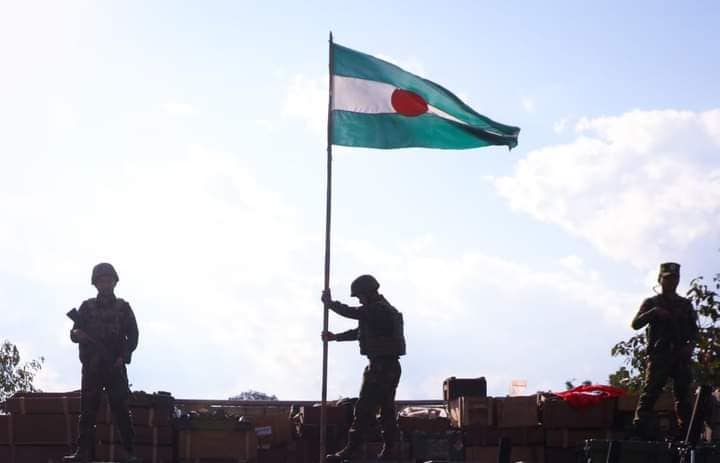Myanmar Spring Chronicle – October 28 Overview
(MoeMaKa) October 30, 2025
Second Agreement Reached to Hand Back Territory Controlled by the Brotherhood Alliance in Northern Shan State
It was announced this afternoon (October 30) that the Ta’ang National Liberation Army (TNLA) and Myanmar’s military junta have reached a second agreement to hand back two towns — Momeik in northern Shan State and Mogok in Mandalay Region — which were captured by the TNLA during the first and second waves of Operation 1027.
Under the agreement, which also includes a ceasefire between the TNLA and the junta beginning at midnight on October 29, the TNLA will withdraw from the two towns while the junta has agreed to halt airstrikes and offensive operations in Ta’ang areas and to refrain from further advances.
The discussions took place in Kunming, Yunnan Province, China, on October 27–28, with the TNLA delegation led by Vice Commander-in-Chief Tar Jot Jar, and the junta delegation led by Deputy Commander-in-Chief Ko Ko Oo. China’s Special Envoy for Myanmar, Deng Xijun, attended the talks as mediator, according to reports.
Although the full text of the agreement has not been released, the key points include:
-
TNLA’s withdrawal from Momeik and Mogok, and
-
The junta’s pledge not to conduct airstrikes, ground offensives, or troop advances in TNLA-controlled areas.
After the MNDAA and the junta reached a ceasefire earlier this year, the momentum of Operation 1027 slowed. The April handover of Lashio also stirred mixed reactions among revolutionary forces. Similarly, this new TNLA ceasefire has generated disappointment among resistance supporters still fighting the junta.
The earlier ceasefire and town handover by one of the Brotherhood Alliance members had already revealed that the goals and interests of ethnic armed organizations (EAOs) and the broader Spring Revolution forces are not fully aligned. Operation 1027 was launched with the declared goal of ending the military dictatorship, and resistance groups across Myanmar, including numerous PDFs, had joined in solidarity attacks at that time.
Although these offensives showcased a rare moment of nationwide unity against the junta, the January ceasefire undermined that unity militarily and exposed political divergences and conflicting agendas among the resistance groups.
Subsequently, disputes and clashes over territorial control between TNLA and other EAOs in neighboring areas further weakened cohesion.
As the situation evolved, TNLA was forced onto the defensive: it lost Naungcho in July, Kyaukme two months later, and most recently Hsipaw, which fell within just two weeks.
While these setbacks do not necessarily mean TNLA has been defeated, its loss of territory, combined with China’s tight pressure on the UWSA — a major source of arms and financial support — has placed TNLA in a difficult position. At the same time, PDF forces in upper Myanmar could no longer provide the same level of manpower and coordination they did during the first and second phases of Operation 1027.
This situation points to a growing gap in objectives and priorities between ethnic armed groups and central Myanmar’s PDF forces. Although some had urged solidarity with TNLA when the junta began new offensives in mid-2025, such coordinated actions did not materialize. Facing isolation, TNLA fought largely alone for months, lost multiple towns, and was ultimately compelled to accept a ceasefire.
Following the announcement, some resistance leaders in central Myanmar called on the public to understand the position of ethnic armed groups, while also encouraging people to redouble their efforts in the struggle against the junta.
The Mandalay People’s Defense Force (MDY PDF) issued a statement the same day, pledging to continue defending its territories under the command of the NUG’s Ministry of Defense, and declaring that TNLA’s ceasefire would not affect its own military operations.
Likewise, the Mogok Strategic Force (PDF) declared that although TNLA had agreed to return Mogok to the junta, they themselves would not withdraw and would continue fighting to defend the town.
These developments emerged within hours of the ceasefire announcement. Many observers believe that with TNLA no longer an immediate target, the junta may now concentrate its forces against MDY PDF and the Mogok Strategic Force.
It is therefore expected that upper Sagaing and northern Mandalay Regions could soon see heightened military activity. Questions also remain over how long the TNLA–junta ceasefire will hold, and whether the junta will use it as a stepping stone to reclaim other key border trade towns, such as Kutkai, that are still under TNLA control.

